CAVAILLON MELONS HERALD THE START OF SUMMER IN PROVENCE
One of my most vivid memories of melon encounters goes back to adolescence: I was staying with a best friend’s family in their cabin in Shaver Lake, a small community nestled in the Sierra Nevada’s of California. I came to the breakfast table and, to my horror, found half of a cantaloupe waiting for me. Panic set in: how could I possibly eat the entire half? Jeralynn and her sisters dug their spoons in with a relish I would reserve for a bowl of dark chocolate ice cream and were finished long before I had managed to swallow just a few bites. When the scrambled eggs arrived—eggs whisked to perfection with a dash of Worcester sauce—I was still working on the melon ordeal. It’s funny that I now can’t recall the fate of the melon but the image of it, staring me down, remains as salient as it did that morning.
I doubt that I let another melon cross my lips until I went to Provence and met the Cavaillon melon. And it was love at first bite. This melon, called the French Charentais from the species Cucumis melo cantalupensis, is succulent, flavorful and fragrant. This European cantaloupe, unlike the North American cantaloupe I grew up with, is a melon into which I plunge my spoon with such unabashed enthusiasm that I prefer to eat it alone in the kitchen.
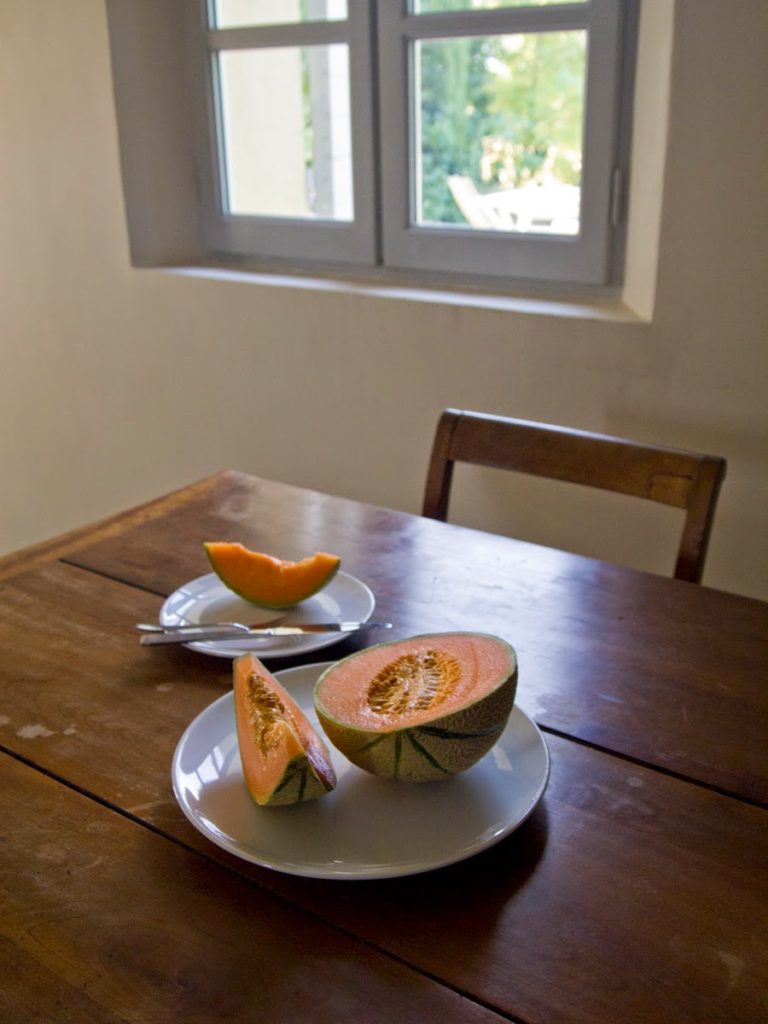
With these coveted melons starting to appear in the markets in Provence and Cavaillon’s annual Melon Festival—Fête du Melon—quickly approaching (June 29-30), I thought it was a good time to turn our attention to Cavaillon and its famous melon.
Cavaillon was a rather unremarkable town of about 25,000 people, until melon mania put it on the map about 25 years ago. To be fair, it has a Roman arch, a 12th-century chapel, an 18th-century synagogue, an 18th-century cathedral, and Chez Auzet’s famous baguettes, but most people know about Cavaillon now because of the melon.
Melon cultivation in this area of Provence probably dates back to the 14th century when nearbyAvignon was the seat of the popes. Apparently, the popes were very fond of melons and grew them in their gardens in Cantelupo, near Rome. It is thought that they brought the seeds of these European cantaloupes with them. By the end of the 19th century, the popularity of this melon was widespread and the Cavaillon produce market drew patrons from all around the area. It is said that Alexandre Dumas, author of The Count of Monte Cristo and The Three Musketeers, donated copies of his books to the public library of Cavaillon in return for a life-time supply of the town’s famous melons.
In the early 20th century, the Charentais melon was introduced to Cavaillon. Now known as “the Cavaillon melon,” this coveted variety of melon actually originated in the Poitou-Charentes region of France, most known for its cognac production. This melon has a particularly potent fragrance reminiscent of flowers and peaches, a luscious sweet taste, like a jar of honey, with a substantive texture that is the antithesis of baby food.
In 1978, an important juncture on the melon’s path to gastronomic fame occurred when French chef Jean-Jacques Prévôt serendipitously ended up in Cavaillon and was introduced to the Charentais melon (as well as the young woman who would become his wife). Three years later, he opened Restaurant Prévôt, a gastronomic restaurant that emphasizes locally grown produce with a particular focus on…guess what! Today, his summer melon-based five-course menu remains one of his most popular offerings. In the latest Michelin Guide (2013), Restaurant Prévôt was awarded a much deserved star.
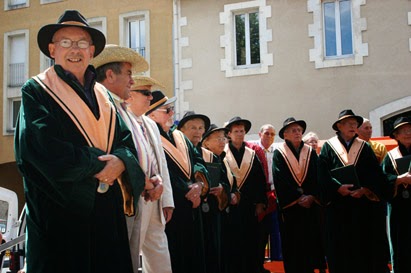
In 1987, the Conférie des Chevaliers de l’Ordre du Melon was formed with the mission of maintaining the integrity of the melon, improving its cultivation, and promoting its cultural significance to Cavaillon. Since 1997, when the melon festival was introduced, this brotherhood, dressed in black robes and wearing ribbons supporting melon medallions around their necks, has ushered in each year’s crop of melons with great pomp and circumstance.
“Melon mania” is clearly the driving theme during this two-day fête. Much like a pumpkin festival in New England—except the smell that permeates Cavaillon is infinitely preferable—melons are arranged every which way and dressed up in creative costumes. Melons are served in every form imaginable, from straight out-of-the-rind to syrup and liqueur and candy and pie. There are culinary demonstrations, music, dancing, parades, and lots of celebration. For a Cavaillon melon is indeed something special.
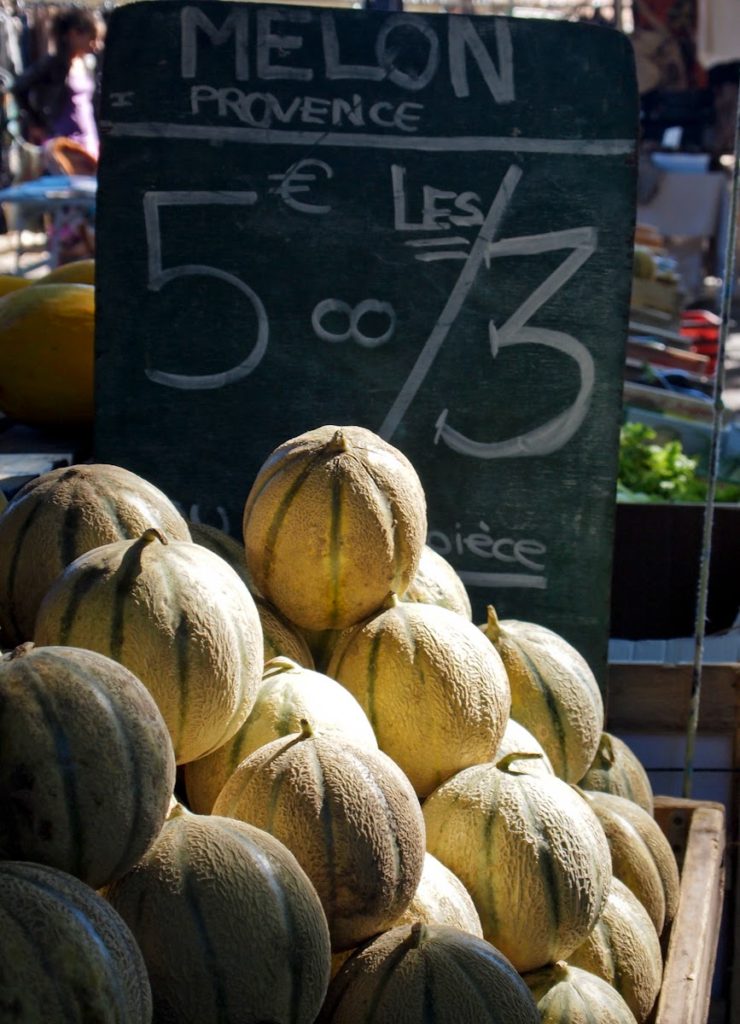
Cavaillon melons are grown from seed and require 80 to 85 days to reach maturation. In April, Cavaillon melons from heated greenhouses start to appear in the markets and in May, those from unheated greenhouses begin to surface. In June, those from heaven arrive—grown en plein champ, these melons were allowed to ripen in the fields under the warm Provençal sun. Experienced growers know just when to pick them—they examine their skin, feel them, tap them, smell them, and caress them. A tell-tale sign of ripeness is the “drop of blood” which refers to the sugar that has leaked out and crystallized. To be classified a “Melon de Cavaillon,” the melon must meet certain requirements for density, sugar content, and appearance.
I am always amazed at the accuracy with which a vendor of Cavaillon melons can predict when the melons will be perfectly ripe. “I’d like one for tomorrow morning and three for dinner on Sunday,” I might inform the farmer. He will carefully inspect a few melons and pick out four. He’s always spot-on.
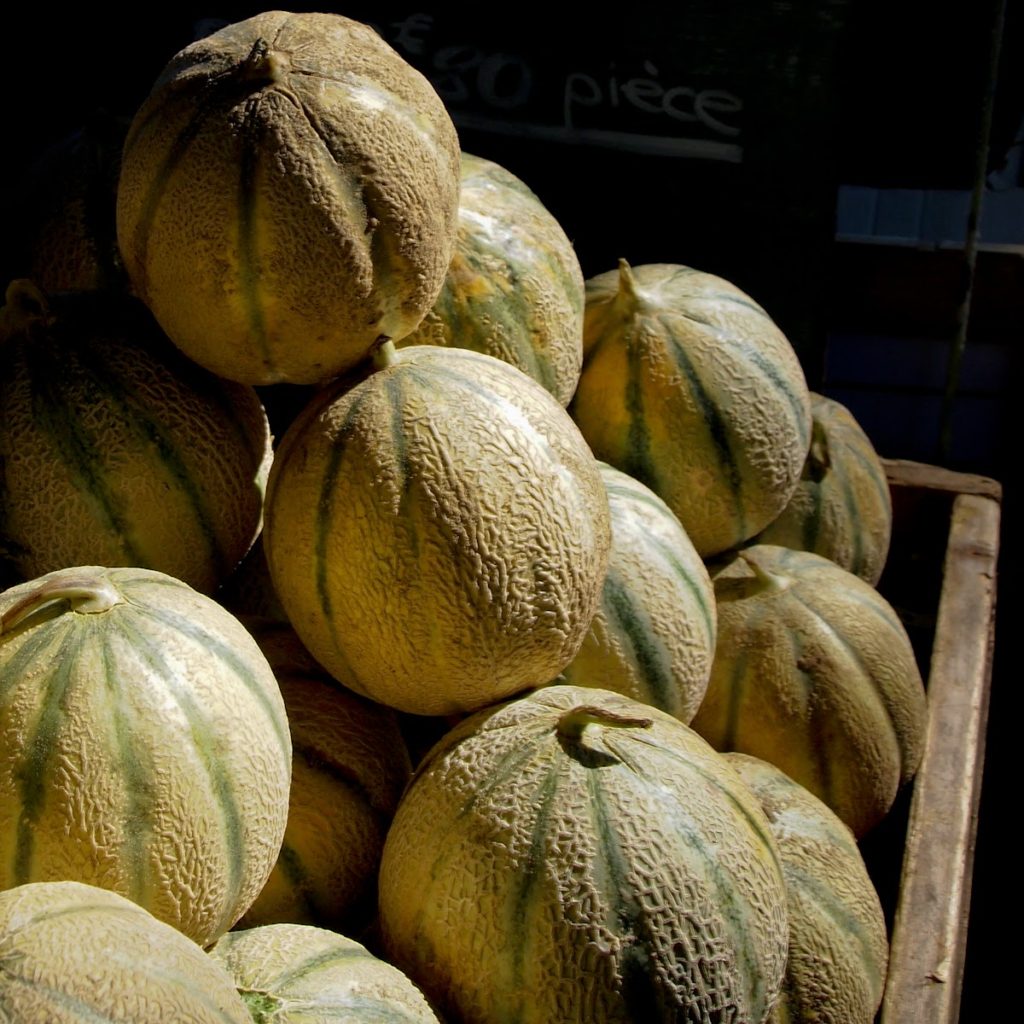
Cavaillon melons not only taste good but they are filled with good things for you. In addition to lots of bioflavonoids, they are loaded with beta-carotene (which the body converts to vitamin A) and vitamin C, both antioxidants, as well as potassium, magnesium, calcium, iron, zinc, copper, manganese, iodine, and a fair amount of fiber. Because they are just slightly larger than a softball, a half-melon is the perfect size and is only 100 calories or so.
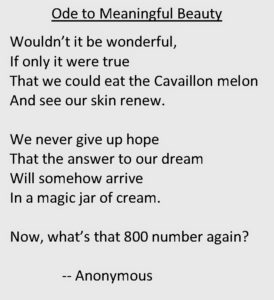 The flesh of Cavaillon melons is so rich in ingredients that promote the growth of collagen and tame the free radicals that hasten aging that a French cosmetic surgeon, Dr. Jean-Louis Sebagh, incorporates it into his skin-care products. You may have seen his alluring infomercials with Cindy Crawford. I was more intrigued than persuaded by these half-hour long promotions—referring to Cavaillon as “a remote region in the south of France, where scientists have cultivated a rare melon containing a powerful super-antioxidant ” bordered on false advertising to me—but my mother was curious and sent away for the products. The “Meaningful Beauty” package arrived when I was visiting her last winter so I got to try them and must confess that I really liked the array of day and night serums and creams for eyes, face, and neck (although I am not any closer to looking like Cindy Crawford).
The flesh of Cavaillon melons is so rich in ingredients that promote the growth of collagen and tame the free radicals that hasten aging that a French cosmetic surgeon, Dr. Jean-Louis Sebagh, incorporates it into his skin-care products. You may have seen his alluring infomercials with Cindy Crawford. I was more intrigued than persuaded by these half-hour long promotions—referring to Cavaillon as “a remote region in the south of France, where scientists have cultivated a rare melon containing a powerful super-antioxidant ” bordered on false advertising to me—but my mother was curious and sent away for the products. The “Meaningful Beauty” package arrived when I was visiting her last winter so I got to try them and must confess that I really liked the array of day and night serums and creams for eyes, face, and neck (although I am not any closer to looking like Cindy Crawford).
I would definitely prefer to eat the Cavaillon melon than put it on my face, but very few leave France. Charentais melons are now grown in this country. I have never seen one stateside but I read in a recent Saveur article that they are sold at the “Bulich stand at the Union Square Greenmarket in New York City.” They are grown on a farm near Albany and are brought to the City twice each week, beginning late July.
I would love to introduce Jeralynn and her family to Cavaillon melons…though I might serve them after dinner with a little Beaumes-de-Venise splashed in the center.
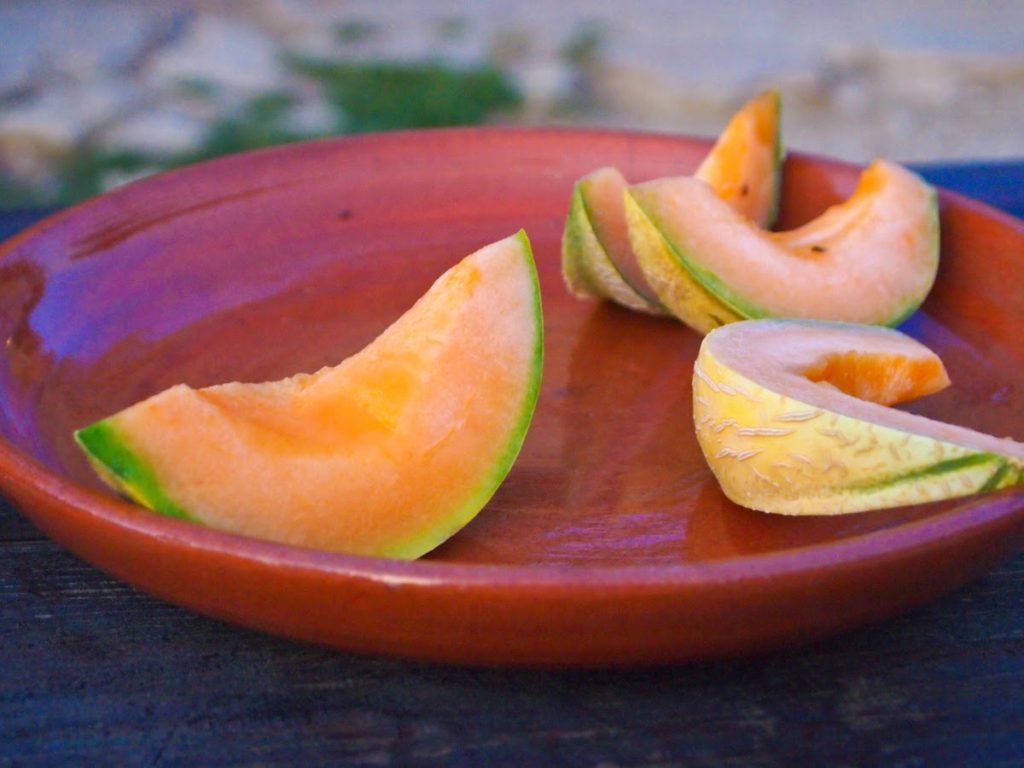

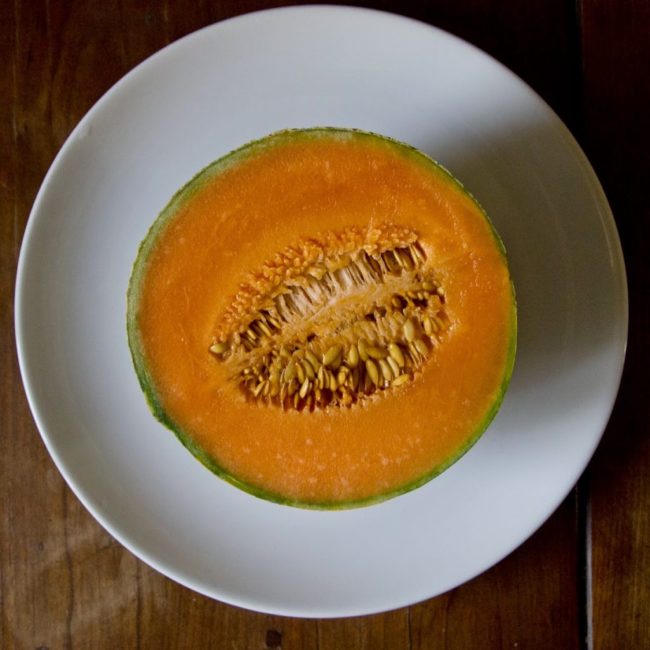
Love your informative posts!
They're even better eaten in the Charante with a splash of Pineau des Charante. Or as a first course with Kalamata olives or ginger jam.
I don't think I have ever had a Cavaillon melon–I have only traveled to Provence in the early spring–but I have just purchased the lotions you refer to and also really like them. I too was skeptical and have to say that the South of France angle sold me. Interesting to know tha history of this magical melon. Merci!
Following up on Ginny's comment, you could have entitled this post, "The Magic Melon." It seems everyone attributes a little magic to it!
Susan – unlike you, I grew up loving cantaloups. We got them fresh from the farmer's market every summer. Once away from home, I was shocked – truly shocked – to find out how bad the ones from the supermarket were. But, even the best of the farmer's market melons don't light a candle to the Mélons de Cavaillon. I was happy to hear one of our farmers here in Tucson saying that he was growing those "provincial" melons – "You know," he said, "the ribbed ones from France" Fingers crossed… ~ David
My father was forever frustrated by the brevity of the Berkshire summers — one year only July was frost-free — that prevented him from bringing cantaloupe to the luscious ripeness he remembered from his Ohio boyhood. Certainly the sweetest I've ever had were from Cavallion, though closely followed by those grown here in the Sonoran desert (not entirely surprising, given melon's origins in the Kalahari).
Merci Kirsten!
I am intrigued by the Kalamata olives! Will try that next time I have a Cavaillon melon! Ginger jam sounds divine as does the Pineau des Charante. I would love to try them in the Charante!
Thanks for the suggestions!
They are nice lotions, aren't they? The allure of the melon certainly adds to the appeal of the lotion!
Yes, indeed!
So, have the French melons arrived in the market yet? Do let us know!
To learn that all melons are not created equal must have been as disappointing as learning who the tooth fairy is! But, like peaches and tomatoes, we keep looking, right?
I love hearing about the origin of certain foods. I imagine that the melon has a long interesting history. I also love to hear of people's early experiences with food and how they shape our preferences and expectations. Thanks so much for sharing. Your father would have liked the Cavallion melons, eh?
My name is David Howze. I live in Spur, Texas but am moving to a larger farm close to Abilene Texas. I have grown every kind of vegetable there is but have become interested in growing things that usually don't grow here. I have grown Goji berries from Tibet and done well in Texas soil. I am looking for anyone who can send me some Melon de Cavaillon seeds. It is supposed to be a real delicious melon like a Cantelope. I would like to try and grow them here. I have good loamy sandy soil, and it grows melons well. But can't seem to find any seeds from this type of melon that grows in France. Can anyone help me find some seeds. I would appreciate it greatly. I would be happy to pay whatever it took to get me some seeds. Please contact me at Dhowze@hotmail.com Happy growing!
Hi, do you have any Cavaillon seeds for sale? if not can you tell me were to purchase some thanks, My name is William please contact me at billcctrust@aol.com
I will be in Cavaillon soon and will follow up!
I have only just recently discover this Cavaillon melon at my local farmers market. Wow! It is divine. My husband especially loves it. You don't have to travel to France to enjoy it. It is right here in the San Francisco Bay Area. You can also enjoy our world famous wineries in Napa Valley.